14 Ingredient Swaps That Make Soup Taste Better
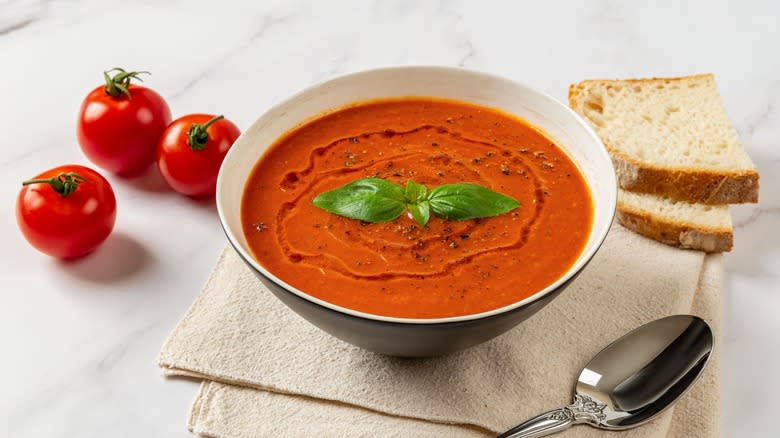
We don't think we'll ever get tired of eating soup. You can make soup out of pretty much anything, using virtually any flavor profile you like, and it'll still come out delicious, tasty, and filling. However, it's no secret that soup isn't the most exciting of foods, and there are times when you wish it were a little more interesting. It's in those moments that you need to consider making some easy swaps to take your soup to the next level.
Because soup is such a rustic and versatile food, it lends itself to a host of ingredient swaps without altering its inherent properties. Swap your vegetables for more interesting choices, for example, and you'll get a much more developed flavor without worrying about its consistency changing. Other swaps, like subbing out croutons for cheese crisps or using chorizo instead of Italian sausage, can add taste and texture. Ingredient swaps aren't the only way to make your soup better, of course: There are plenty of tips for making soup like a professional chef, from using the right fat to nailing your mirepoix, which will raise your soup game. With these easy subs, though, you can put an exciting spin on your weeknight meal.
Read more: French Cooking Tricks You Need In Your Life
Swap Your Heavy Cream For White Beans
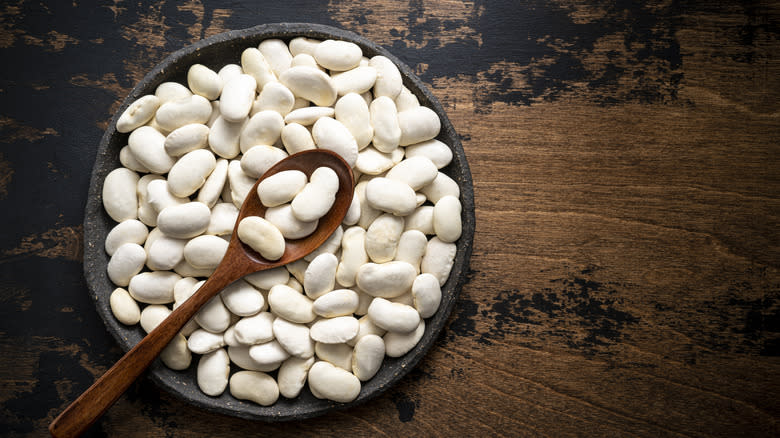
Adding a creamy element to your soup recipe is a quick way to thicken its consistency and add immediate, deep flavor. While most people use heavy cream for this, there's a secret ingredient celebrity chefs use to perfect soup that you might not expect: white beans. This addition is an ingenious trick used by Giada De Laurentiis, who adds blended white beans to her sundried tomato soup. The beans give the soup a smooth texture, thanks to their starchy, soft flesh, and do so without flooding your dish with fat or dairy.
White beans also have a subtle flavor that doesn't dominate your soup but melds seamlessly into its profile. The fiber in white beans makes your soup more filling, and their protein helps on this front, too. The best part is that you can blitz your white beans to your desired consistency. Fancy a slightly chunkier soup? Don't purée them, and instead leave them in slightly smaller pieces. If you want a smooth bean paste, blitz them until they're completely broken down, with a little water or vegetable stock.
Sub White Wine For Red Wine In French Onion Soup
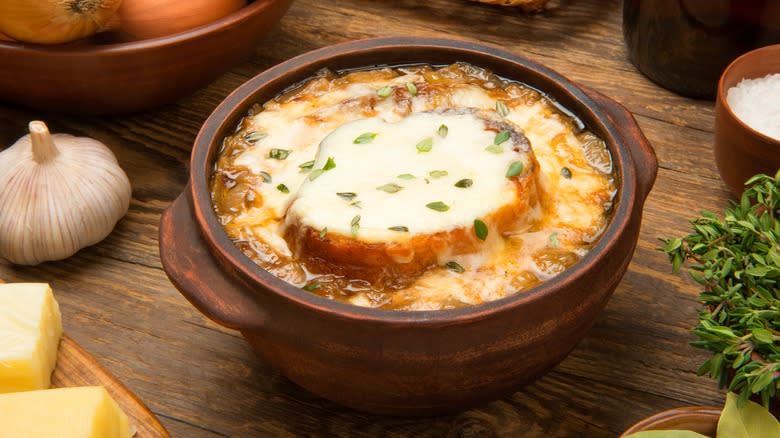
French onion soup is a favorite across the world and delivers deep, rich, layered flavor in every spoonful. One of the reasons it does this is thanks to the white wine that goes into standard French onion soup recipes and deglazes the pan, which helps to activate and develop its savory flavors. If you want to take things to the next level, though, give your French onion soup some flair with red wine.
Using red wine instead of white gives your French onion soup a deeper, plum-like flavor. Red wine goes excellently with the beef stock and helps to bring out its umami notes, and it also deepens the color of the soup, making everything look richer. The complex flavors of red wine also work in excellent contrast to the salty, creamy cheese that adorns each crouton.
When using red wine in French onion soup, it's important to pick your vintage carefully. Opting for a red wine that's too rich or dark will drown the subtleties in your soup and make it taste too heavy. Go for a lighter red instead. A light red will give you all of that beautiful depth, without becoming the overriding flavor in your soup.
Use Leeks Instead Of Onions
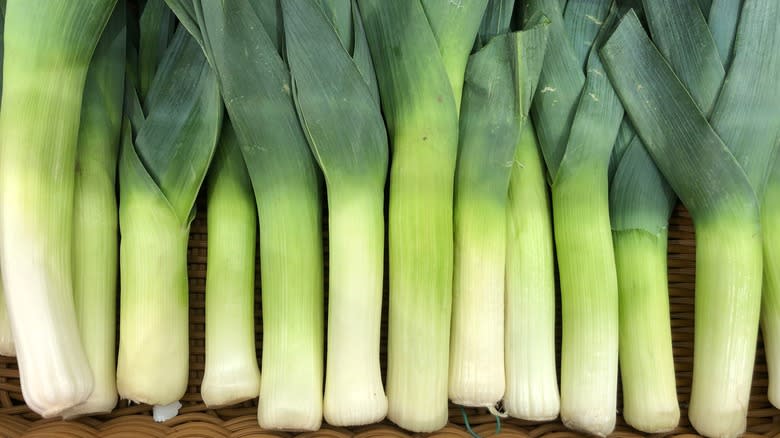
One of the best swaps you can make in your soup is also one of the easiest. Instead of using regular onions in your soup base, use leeks. Leeks work with virtually any soup. They also have a slight sweetness and lightness that adds layers of flavor to your dish.
When cooked slowly, leeks soften into a gloriously squidgy tangle, and their flavor deepens even further. If you want to add serious taste to your soup, brown your leeks to bring out a burst of caramelized flavor. Doing this harnesses the power of the natural sugar in your leeks, and adds a nutty, molasses-like note that can't be replicated by adding other sweeteners. Just cook your leeks before adding any other ingredients (for 20 minutes or so), stirring them occasionally to stop them from sticking. Then, deglaze your leeks with some wine or vegetable stock to ensure you scrape up all the delicious food particles on the bottom. Throw in your other soup ingredients, bubble everything together until your soup's ready, and then chow down.
Instead Of Regular Canned Tomatoes, Use Roasted Tomatoes
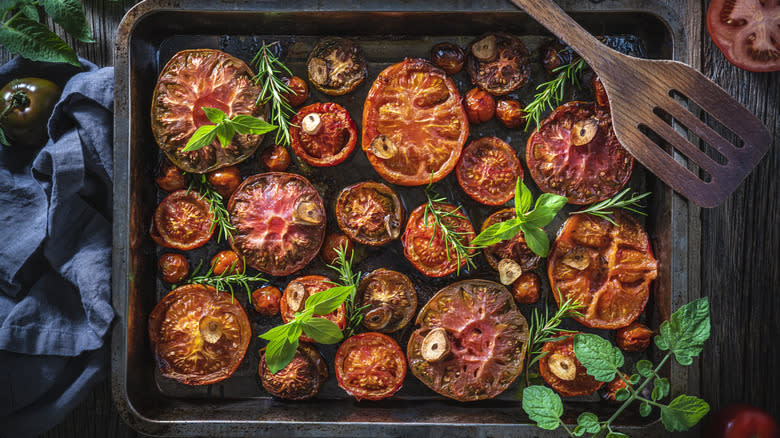
Canned tomatoes give countless soups a tangy, savory flavor base and a fibrous bulk. However, you miss out on a whole lot of extra taste when you use them, which is why we love using roasted tomatoes instead. Roasted tomatoes are the trick to elevate your spaghetti sauce. In soup, they work the same way, offering an intensified savory flavor, with a hint of smokiness from the char the fruit develops when cooked with dry heat.
Roasting your tomatoes is simple: simply place them on a baking sheet and pop them in a hot oven until they blister and brown. Cherry tomatoes are usually the easiest to roast, as they develop color and cook quickly, but you can use any variety you wish. You can also roast tomatoes in the air fryer to speed things up. To use roasted tomatoes in your soup, substitute your regular canned variety with them, using roughly the same amount. Because roasting tomatoes reduces their moisture content, you may need to add more stock to loosen them.
Sub Your Garlic For Wild Garlic

Garlic shows up in virtually every soup recipe out there, and when it's missing, you notice its absence. Garlic gives any soup a deep, intense flavor and fragrance, which makes your meal taste fuller. If you're looking for a subtler garlic flavor, though, wild garlic is an ingenious swap that adds a certain delicacy to your dish. Wild garlic's flavor somewhat sits in the middle ground between onion and regular garlic, with a gentler garlicky taste accompanied by a hint of chive.
The only issue, of course, is that to use wild garlic, you'll need to find it first. Wild garlic usually grows in the Eastern half of the United States and generally grows in shaded woodland. You can identify it by its flower, which is a small, white, star-shaped bloom, as well as its unmistakable garlicky scent. One of the best things about using wild garlic is that it's easy to prepare: you can chop up the whole plant and throw it into your pot. Because it's so delicate, it's best to use it towards the end of the cooking process, as you would a chopped herb, so you don't destroy its flavor.
Rather Than Croutons, Use Cheese Crisps

We're always looking for excuses to add more cheese to our food, and so replacing croutons with cheese crisps is a swap we will always get behind. Using cheese crisps instead of croutons gives you all the crunch that the dried bread cubes provide -- and with added umami flavor. A cheese crisp garnish is also a great move for individuals trying to keep their carb content down, and it works well with keto soup recipes.
Making cheese crisps is more simple than you think, and doesn't take much longer than making homemade croutons. You have to take slices or small mounds of grated cheese, lay them out on a baking sheet lined with parchment paper, and bake them. The cheese slices will first melt, and then start to bubble, before turning crispy. You'll get the best results with a firmer cheese, as looser and more moist options will be too gooey. Swiss and parmesan are our two favorite varieties, with parmesan giving you an ultra-intense flavor that can bolster the taste of your soup.
Swap Half-And-Half For Cashew Cream
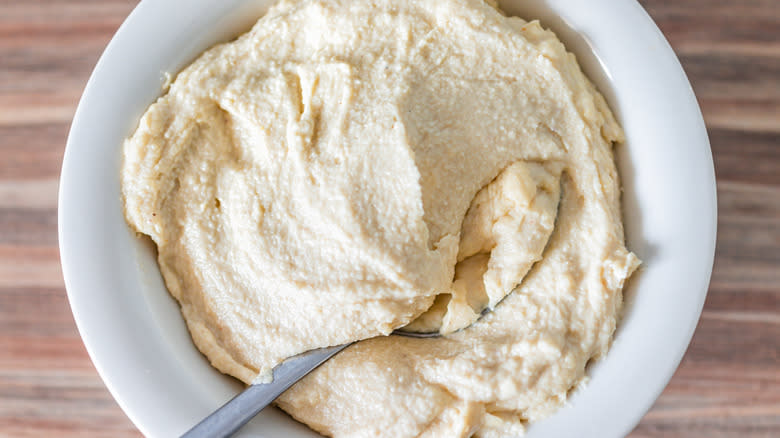
If you want to give your soup a little creaminess, half-and-half is usually the way to go. However, half-and-half has two main issues: it's a fairly uninspiring flavor and it's full of dairy. The latter may make it incompatible with certain dietary requirements. That's why we love using cashew cream instead. Cashew cream gives your soup an ultra-creamy, thick consistency, with a subtly nutty, velvety flavor that helps combine the individual ingredients' tastes.
Cashews are often used as a cream cheese substitute, and because cashew cream is so thick, you might be a little worried about putting it in your soup. The thickness of cashew cream, however, is its strength, giving your soup loads of body without reducing its flavor. If you need to, you can always loosen your cashew cream with a little extra broth. Cashew cream works particularly well in vegan tomato soup recipes, where its creaminess gives you that bright orange Campbell's Soup appearance, and its gentle flavor helps to reduce any unnecessary acidity.
Omit Your Dried Herbs And Use Fresh Ones
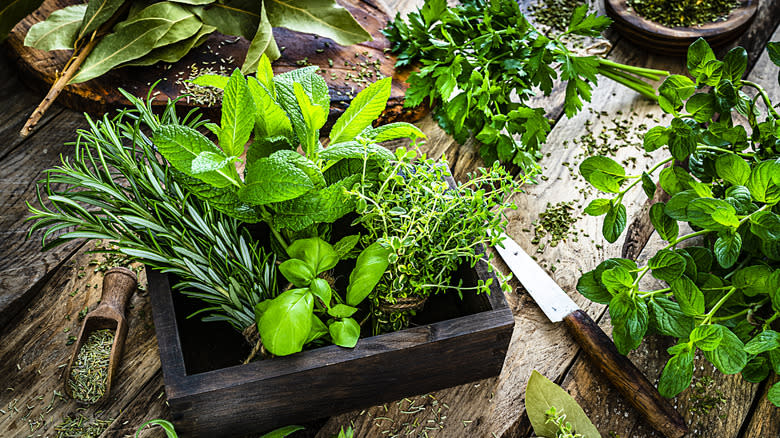
Dried herbs are a speedy, cost-effective way to add instant complexity to soup. While they give an intense herbal flavor, they can often end up being a little dull, especially if your herbs have been sitting in your pantry for a while. Using fresh herbs is the quickest way to rectify this. Fresh herbs supply all of the brightness and floral fragrance that dried herbs can lack, and they also give your soup a more appealing visual impact, with their green notes acting as way more enticing than the grayish flecks of color that dried herbs provide.
Make sure you're converting properly when substituting fresh herbs for dry herbs. As a general rule of thumb, you'll want to work with a 3:1 ratio of fresh to dry -- so for every teaspoon of dried herbs you use, substitute a tablespoon of fresh ones. However, remember that this may not be a failsafe conversion, as some fresh herbs can be less intense than others. The easiest thing to do is add less, instead of more, and taste-test your soup religiously, throwing in more fresh herbs if you need a boost.
Swap Instant Bouillon For Homemade Stock
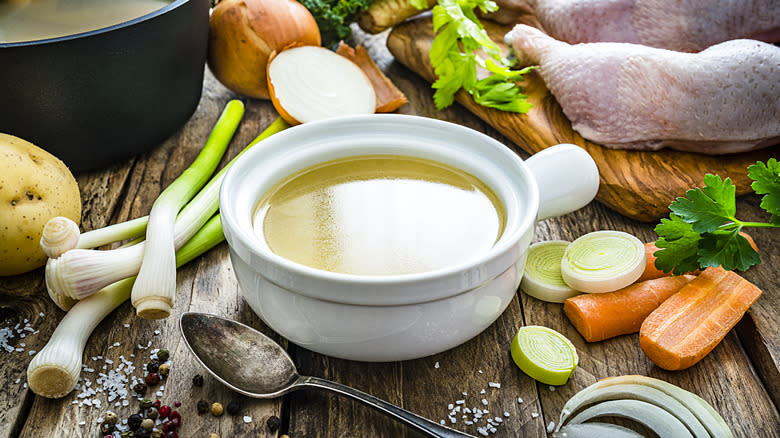
As soup is primarily liquid, the liquid you use to make it matters. While water can work well as your soup base, most people opt for instant bouillon, which gives easy flavor in seconds. The problem with instant bouillon is that it's often lacking in complexity, and tends to be too salty. Luckily, using homemade stock can help you avoid that, and add a huge amount of flavor to your soups with barely any work at all.
Most people are put off the idea of making their own stock because it seems like an arduous process, but in reality, it's as simple as putting ingredients in a pot and letting them simmer, until the liquid extracts all the flavors of your additions. Although this can take some time, there are some ingenious methods to speed things up. Using your Instant Pot to make easy chicken stock harnesses the power of pressure cooking, allowing you to produce deep flavors and heady fragrances in as little as 30 minutes. Making your stock also allows you to control exactly how much salt you put in it, so your soup doesn't come out drowned in sodium.
Switch Up Your Sour Cream And Use Greek Yogurt Instead
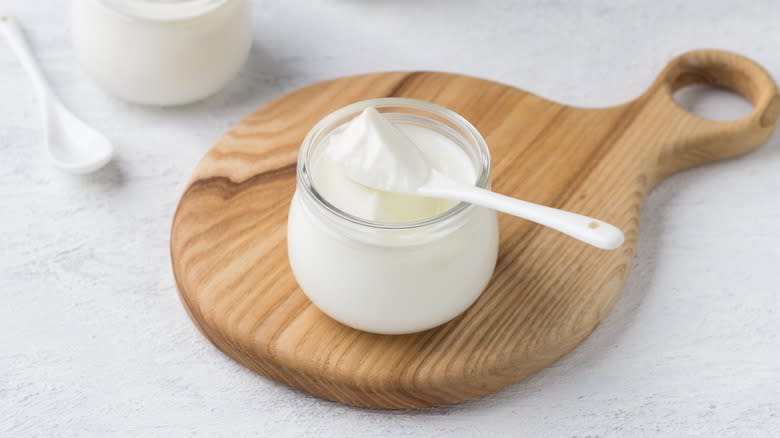
Finishing off your soup with a dollop of sour cream is a quick way to make it both look and taste good. For a slightly more complex flavor, though, use Greek yogurt instead. Greek yogurt is one of many sour cream alternatives you can use in your soup, but it stands out thanks to its fermented nature, which gives it a slightly acidic, tangy taste that helps to cut through its density. That very density is also partly what makes it amp up your soup so much, adding creamy thickness instantly.
When using Greek yogurt, make sure you go for a full-fat version wherever possible. Low-fat and fat-free versions can be thinner and runnier, and their higher protein-to-fat ratio can cause them to split when heated. Make sure you also go for unflavored natural Greek yogurt, as any added sugars or ingredients may throw your soup's flavor profile off-balance and ruin your hard work. If you don't have Greek yogurt or sour cream, you can also use alternatives like coconut milk or buttermilk. Just bear in mind that these will be thinner, which may risk diluting your soup.
Instead Of Heavy Cream, Use Coconut Cream
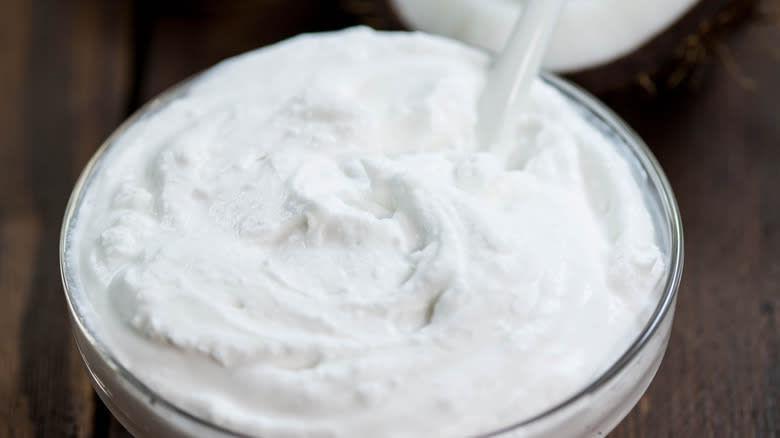
Heavy cream is a game-changer when added to soup, giving your broth immediate lusciousness and making everything taste richer. However, swapping it for a vegan version can give you a flavor you didn't know you were missing. Coconut cream is an easy substitute for heavy cream and is a more concentrated version of coconut milk. This concentration gives it a deep coconut flavor, which provides your soup with a gentle fruitiness.
Coconut cream can be quite thick, but don't let that put you off. Just spoon it out and drop it into your soup, where it'll loosen up and melt into your stock, thickening it instantly. Coconut cream, like heavy cream, is high in fat, so use a little at a time to stop your soup from becoming greasy. Additionally, make sure you check the name of your product carefully. Cream of coconut looks similar to coconut cream, but it's generally sweetened and may make your soup taste too sugary. Some coconut cream products may also have added ingredients or sweeteners.
Rather Than White Potatoes, Use Sweet Potatoes
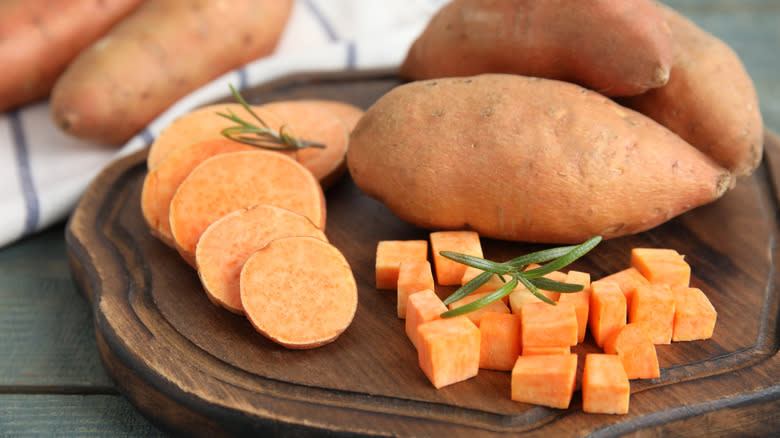
Potato is a frequent ingredient in soup recipes, where it adds some important starch and carbs, making your meal way more substantial. It's hardly the most exciting addition in the world, though, and while it capably takes on the flavors of your soup, it rarely stands out. But sweet potatoes? They're another matter. Sweet potatoes and white potatoes (which aren't as related as we thought) are virtually interchangeable in soup recipes, and using the former gives you a boost of sweet, yet earthy flavor.
Sweet potatoes are highly versatile and go just as well in lighter, brighter soups as in dense, deeply savory ones. They also add a delightfully bright color to any soup, either in pops of vibrant orange if left in chunks, or with a slight orange tinge spread through your soup if blended. Because sweet potatoes cook slightly quicker than regular potatoes, you'll want to add them slightly later than you normally would. It might be worth peeling them for your soup, too -- the skin is edible but can be a little tougher than white potato skin, and so will likely be more noticeable.
Throw In Chorizo Instead Of Italian Sausage

There's no denying the flavor that Italian sausage gives soup. Its salty, fatty, herbal notes bolster pretty much any broth and go perfectly with leafy greens and potatoes. If you want to spice things up even more, though, use chorizo. Both Mexican and Spanish chorizo can give your soup an immediately savory flavor, a pop of heat, and the deep warmth of paprika.
When choosing your chorizo, remember that different varieties have different cooking requirements. Spanish chorizo is precooked, whereas Mexican chorizo is made from uncooked pork, and so needs ample cooking for it to be safe for consumption. Mexican chorizo may also have a slightly spicier, potentially more acidic flavor than the Spanish version, which is primarily paprika-based. Like Italian sausage, chorizo goes excellently with kale and potato, but it can be used in pretty much any soup you like. It's especially good with beans, with the spiciness of the sausage offsetting the creamy, earthy flavors of the legumes. Chorizo also goes well with pulses like lentils, with their slight nuttiness helping to cut through any potential greasiness from the sausage.
Swap Your Croutons For Halloumi
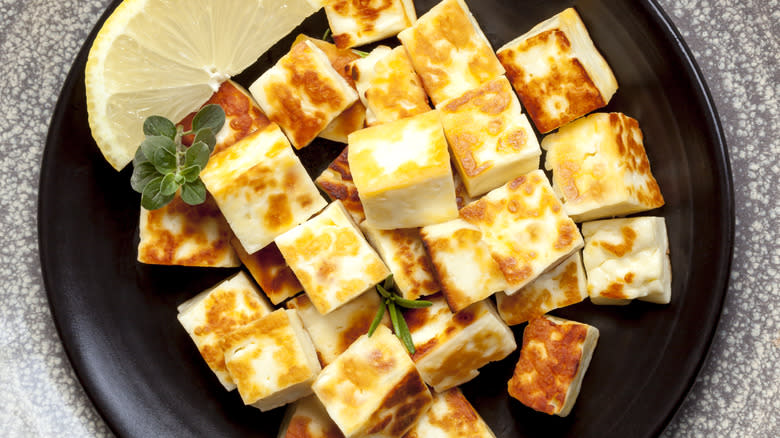
Croutons can make or break a bowl of soup, and a bad crouton can be worse than not having any at all. To avoid boring, flavorless croutons, we recommend skipping the bread entirely and making croutons out of halloumi cheese. Halloumi's firm nature means that it holds its shape in soup, even when the broth is piping hot. It also browns excellently, giving your cubes a deeper, more caramelized flavor and a crunchy exterior, and can be cut to any size you wish.
Don't forget, too, that you can flavor halloumi in the same way you would croutons. Try pan-frying it with garlic and mixed herbs to give your cubes a more developed flavor. Alternatively, you can give them an extra sweetness hit by sautéing them with a drizzle of honey, or add some heat with a sprinkle of chili flakes or cayenne pepper. Halloumi is also a great choice for low-carb soups, and its bouncy, squeaky texture makes it super kid-friendly. Honestly, what's not to love?
Read the original article on Daily Meal

